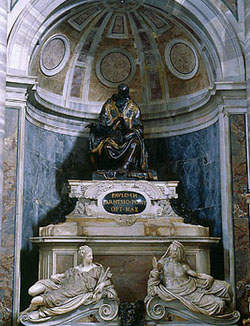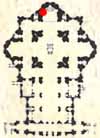 |
| Grottoes
Vatican City Colonnade Saints Floorplan #2 |
| Altars
Monuments The History |
|
Related Sites |

|
This pope convoked the Council of Trent in 1547, and commissioned Michelangelo to paint the Last Judgment in the Sistine Chapel and direct the work of building the basilica. The allegories of Justice and Prudence, are said to be likenesses of the Pope's beautiful sister Julia and his mother.
|
 |
From
'St. Peter's - Guide to the Basilica and Square'
On the left of the Altar of the Chair is the Monument to Paul III (1534-1549),
the Pope who in 1545 convoked the Council of Trent and in 1547 commissioned
Michelangelo to direct the work of building the basilica. The monument
was made by Guglielmo della Porta (1533-1602) who probably used a drawing
by Michelangelo. The bronze statue of the Pope crowns the pyramidal monument.
Below, two marble figures allude to Justice and Prudence. The first statue
is a likeness of the Pope's sister, Julia; the second, of the Pope's mother.
This monument was first placed in the Gregorian Chapel, then in 1628 Bernini
moved it here.
From: 'St. Peter's Basilica - A Virtual Tour' by Our
Sunday Visitor
Although, Della Porta had imagined it differently, his Monument to Paul
III, in its re-composition, after the removal of two statues transferred
to Palazzo Farnese, is in any case one of the most excellent in the Basilica,
due to its sober and harmonious architectural layout. In it, the noble
expression and attitude of the Pope stand out, as well as the proud severity
of the two allegorical statues of Prudence and Justice.
It is said that Della Porta executed the work under the supervision of Michelangelo and in effect, the style of the seated statue of the deceased is Michelangelesque. The same can be said even more so of volutes below, like those in the Medici Tombs in the New Sacristy of the Church of St. Lawrence in Florence; especially with regard to Prudence, with the symbols of the book and the mirror, which evoke some of the faces of Michelangelo's Sibyls.
Of great value, due to its rarity, is the mask in Ancient Yellow and Black marbles placed between the two statues, a classic work found in the Farnese Gardens on the Palatine. According to the initial projects, the sepulcher composed of eight statues was to be placed at the center of the Tribune; but Michelangelo opposed this idea, also insisting on its reduction to four statues.
In this form it was placed in the center of the Gregorian Chapel, from where it was transferred to the back of the south-east pier of the Dome; after which, for its final placing by Bernini, it was necessary to reduce the allegorical statues to two.
From:
'THE NEW SAINT PETER'S'
On the left is the monument to Paul III Farnese (1534-1549) by Guglielmo
della Porta. Here already there is a departure from the architectural
model of the papal tombs of the 1500's, with the figure placed between
alternating niches and pilasters. The figure of the Pope here dominates
from above; his protective gesture is a marvel of power and decisiveness.
Below, on a base of African marble, recline the figures of Justice and
Prudence. Tradition asserts that Justice bears the features of Giulia
Farnese, the Pope's sister, who was famous for her beauty. Originally
the figure was nude, but in 1595 Cardinal Farnese, although he admitted
that Justice should keep nothing hidden, had her covered - not quite skillfully
enough to disguise the modest alteration - with a blanket of whitened
metal; meanwhile old Prudence, severe and dignified, continues to exhibit
her melancholy nudity.
From: 'Saint Peter's'
by James Lees-Milne
Urban was not the man to hesitate in choosing the most conspicuous site
available in the basilica for his own memorial. He took the niche on the
right-hand side of the western apse, where Bernini was later to construct
the cathedra, now the focal cynosure of the whole interior. At the same
time he had removed to the balancing niche on the left side of the apse
the tomb of Paul III, to which he intended his to be a sort of superior
pendant. In fact, the outstanding quality of Bernini's monument was meant
to be no slight reproach to the earlier one which had been sculptured
by Guglielmo Della Porta under Michelangelo's direction. Paul III's monument,
in spite of the ridiculous stance and pose of the two allegorical figures,
is still one of the best in St Peter's. The pope's seated effigy combines
pathos and nobility. Unfortunately, the composition of the monument is
incomplete. Della Porta resented the advice of Michelangelo, to whom he
owed his advancement, and turned against him. Michelangelo thereupon refused
to allow the monument to be sited in the apse, insisting upon it being
put against one of the piers. It was subsequently shifted into other positions.
In the process it lost the allegorical statues of Abundance and Peace.
Only those of Justice and Prudence survived. The former, a naked representation
of Paul III's seductive sister, Giulia Farnese, was given a metal tunic
by Pope Innocent X; the latter, an old hag in the likeness of the pope's
mother looking at herself in a glass, was suffered to remain nude down
to the navel.

